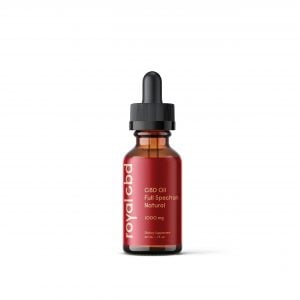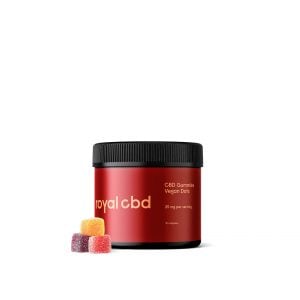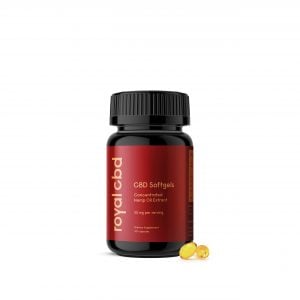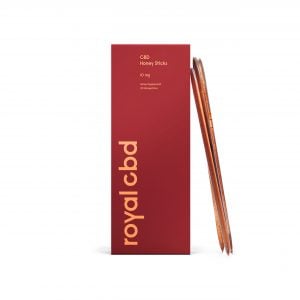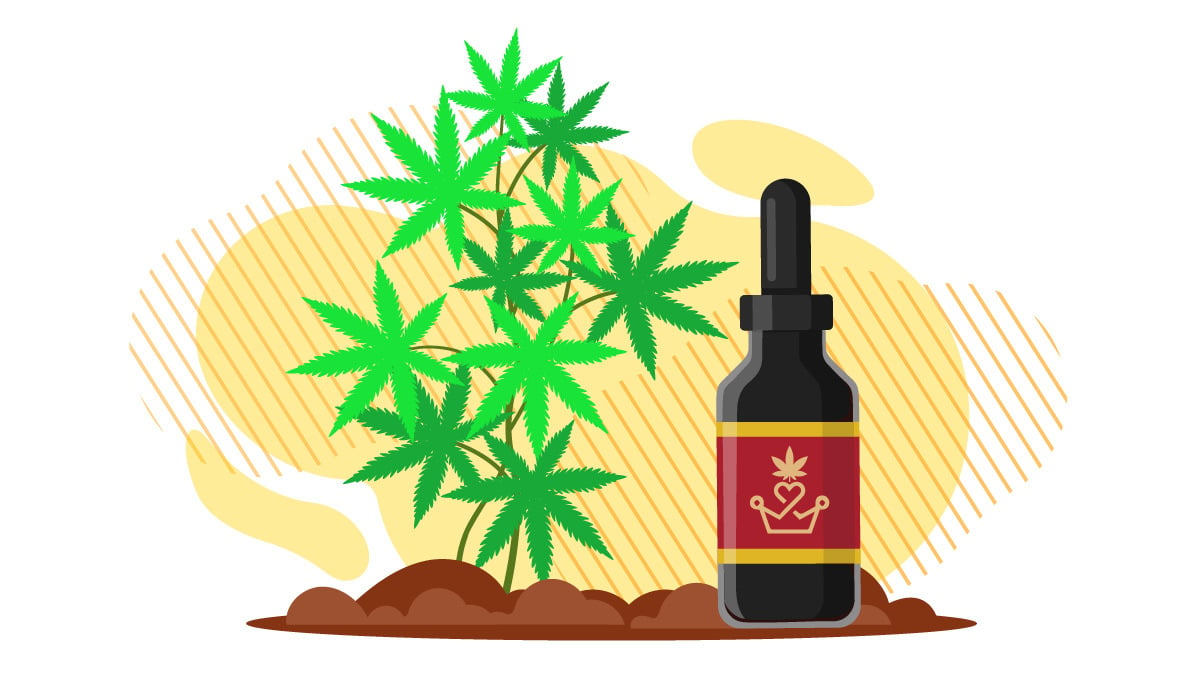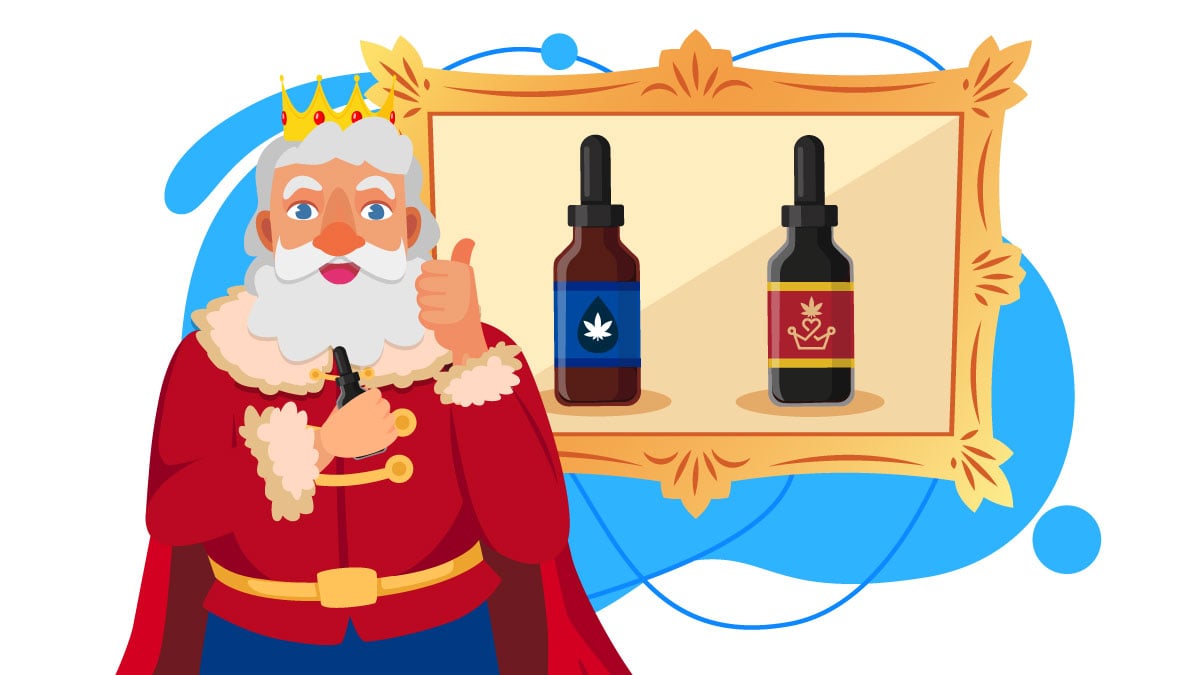There are many ways to benefit from the effects of CBD.
Some people take CBD oil as tinctures, others like to pop capsules or edibles.
There are also those who prefer dabbing CBD concentrates.
Although each method has its own benefits — nothing compares to the efficacy offered by vaping CBD oil.
However, not all CBD oils can be vaped.
You can’t just pour your regular CBD oil into a vape pen and expect it to bring you relief — it doesn’t work that way.
Most likely, you will destroy the vaporizer in the process and waste your precious oils.
Vaping CBD calls for using a special type of CBD oil, also known as CBD E-liquid.
But before we elaborate on which CBD oil you can vape and which not, let’s talk about the many benefits of vaping cannabidiol.
Why Should You Vape CBD?
There are many arguments for vaping CBD, from health to convenience and ease of use. In this section, we go over the 5 most important benefits of vaping CBD oil.
1. Vaping CBD Hass Higher Bioavailability
Bioavailability refers to the amount of CBD that makes it to one’s bloodstream after consumption. The higher the bioavailability, the more cannabidiol you deliver to your system.
For example, the bioavailability of oral CBD, such as capsules and edibles, is roughly 4% to 20%. This means that in the best-case scenario, only 1/5 of the active substance will reach the bloodstream (1).
The bioavailability of sublingual products (oil drops, tinctures) turns out slightly better, varying between 25% – 35% (2).
Vaping CBD oil is the most efficient consumption method as it ensures that up to 56% of the cannabinoid content will enter your bloodstream (3).
Conclusions?
You need far less CBD to feel relieved when you vape CBD oil instead of using drops or grabbing a CBD-infused snack.
2. Vaping is More Convenient
Most vaporizers on the market are easily concealable; some units are as small as the pockets in your jacket.
Given the above, vaping CBD oil is one of the most convenient ways to take cannabidiol. All you need to do is load your vape pen, select the desired temperature, heat the oil up, and inhale the CBD-rich vapor to your lungs.
3. Vaping Gives You Precise Control Over the Dosage
CBD vape oil is generally marked with the total amount of CBD per bottle. A typical vape tank can hold 1 mL of oil.
If you want to calculate how much CBD is in a single serving of your vape, you’ll need to know the amount of cannabidiol per each mL of the liquid.
For example, if you have a 30 mL bottle containing 1000 mg of CBD, each mL should contain around 33.3 mg of CBD.
If your recommended dose of CBD is 25 mg daily, you’ll need less than one full charge to get the effects, so there will be some CBD oil left in your cartridge the following day.
4. Short Onset of Effects
When you eat a CBD edible, you’ll have to wait for anywhere between 30–90 minutes until you can feel the effects. While CBD lasts longer when consumed this way, you may not be satisfied if you’re aiming for instant relief. That’s because oral CBD must pass through the digestive tract before moving into the bloodstream.
Tinctures are absorbed faster because they reach the bloodstream via the capillaries gland in your mouth, which reduces the onset time to around 15–20 minutes after ingestion.
But to be honest, nothing can beat the speed of the vaporized CBD. When vaped, CBD gets diffused directly into the bloodstream through the lungs. This allows the user to avoid the so-called “first-pass effect” so they can feel the effects of CBD almost instantly.
5. Enjoyable Form of Consumption
With all the extra flavors you can infuse into your CBD vape oil, vaping is considered by many to be more enjoyable than other forms of consumption.
When you vape CBD oil, not only can you revel in different aromas and flavors, but you can also puff much denser clouds of vapor than if you vaped CBD flowers or concentrates.
Given the above qualities, vaporization is more attractive for younger users. About 37% of 12th graders in the US (3.6 million) admitted to vaping in 2018. With the increasing popularity of CBD oil, teens and young adolescents may begin to turn to a safer alternative to addictive E-cigarettes containing nicotine.

Can You Vape CBD Oil?
Yes, but not all CBD oils are created equal and thus not every CBD oil can be taken with the intent to vape.
Some CBD oil products are too viscous to be vaporized, while others have been designed exclusively for vaping but shouldn’t be ingested orally.
There’s also the third type — one you can either eat or vaporize.
Ready to learn the do’s and don’ts behind different types of CBD oil?
CBD Oil vs. CBD E-Liquid vs. Cannabis Resin Oil: Which Ones Can I Vape?
There are three types of CBD oil products you may come across when looking for CBD oil online:
- CBD oil made with vegetable carrier oils
- Vape oil made with vegetable glycerine
- Cannabis resin oil made from the concentrated waxes of the hemp plant
Here’s what you need to know about these options in terms of vaping CBD oil.
1. CBD Oils
The term CBD oil refers to an ingestible form of cannabidiol that should be used sublingually (under the tongue) or added to a meal. They’re made with vegetable carrier oils like olive oil, coconut oil, or hemp seed oil.
But can you vape this CBD oil?
If you don’t want to send your vape pen straight to a junkyard or get sick for the rest of the day — then the answer is no, you can’t. Vegetable oils are made up of triglycerides containing three fatty acids each — if you try to burn these you’re going to get some nasty byproducts entering the lungs.
This is part of the process used to make biodiesel — something you don’t want to be inhaling.
CBD oils like this are infused into some kind of food-grade oil like hemp seed oil or olive oil so your body can absorb and digest the product efficiently.
Food-grade oils shouldn’t be vaped — if you tried you would have a really bad time.
2. CBD E-Liquid
CBD vape oil, also known as CBD E-Liquid or vape juice, is a product that’s been designed specifically for vaping.
As mentioned, the extracted CBD oil is too thick to be used in a tank or vape pen and contains the wrong types of oils to be safely vaporized.
To make a vape E-liquid, the fatty acids are removed from the triglycerides that make up vegetable oils. What’s leftover when these fats have been removed is a sugary backbone — known as glycerol. This is commonly referred to as vegetable glycerine.
This substance vaporizes under low temperatures to produce thick, relatively cool clouds of vapor.
CBD E-liquids can be made using the following ingredients:
- Polyethylene glycol (PEG)
- Propylene glycol (PG)
- Vegetable glycerine (VG)
The majority of “cheap” CBD vape oils often use PEG or PG. These substances aren’t the safest to vape because the glycol molecules can break down into carcinogens when heated. It’s best to steer clear of such compounds in your CBD vape oil.
Vegetable glycerin is considered the safer base for CBD vape oils. There’s some evidence that VG can stiffen the soft coverings of the lung tissues in some users, but in order for something like this to happen, an individual would have to vape large amounts of vape oil with vegetable glycerin from a dubious source.
There’s also one more option to consider — triple distilled MCT oil. This is a colorless solution that can be extracted from coconuts. It’s currently one of the fastest ways of administering CBD throughout the body considering the way the fatty acids from MCT oil are used for energy.
Compared with other thinning agents, MCT oil is completely natural and entirely safe for vaping for all types of CBD users.
3. Cannabis Resin Oil
This type of product is an unrefined, highly-concentrated cannabis oil that can be vaped in a vaporizer or taken orally. The difference between cannabis resin oil and CBD oil is that the latter contains only trace amounts of THC, whereas cannabis resin comes with significant levels of this compound.
Cannabis resin oil is obtained through ethanol extraction and thus can be applied sublingually as a tincture. It also belongs to the group of cannabis concentrates, meaning it can be used in a portable vaporizer (don’t confuse vaporizers with vape tanks and vape pens).
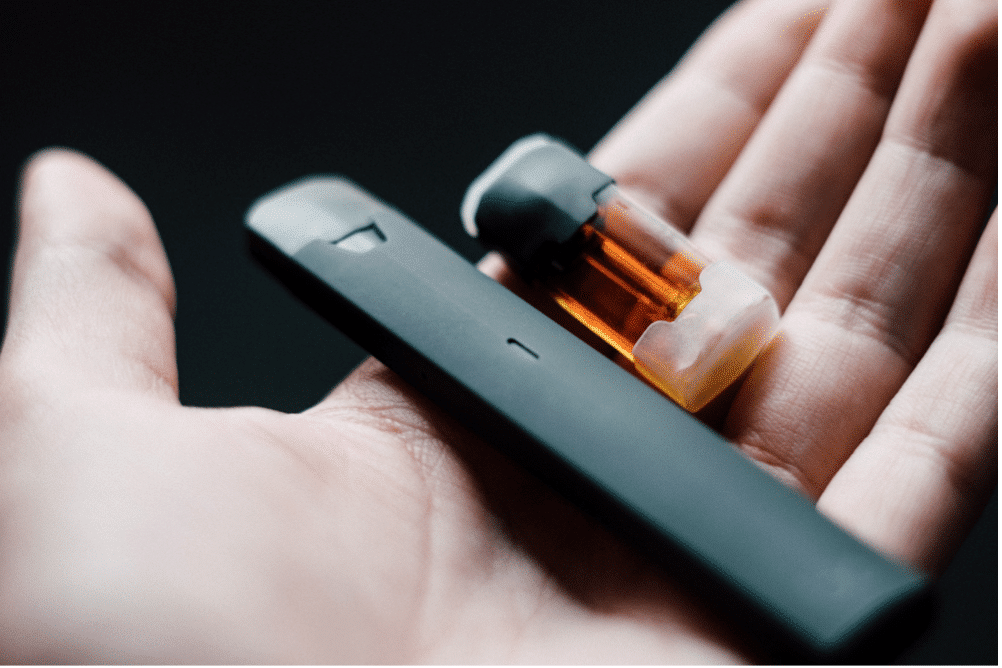
Potential Risks of Vaping CBD Oil
A small number of CBD users can have allergic reactions to some of the compounds used in vapes. There is also some evidence to suggest that products designed for vaping can be contaminated with heavy metals, being another concern among novice vapers.
Let’s talk about the possible downsides to using CBD vape oil.
1. Heavy Metal Contamination: Is Vaping CBD Bad for Your Lungs?
Vape pens come with heating elements that are typically made of stainless steel, nickel-chromium alloy, or pure nickel wire.
A study published in the International Journal of Environmental Research and Public Health expressed a small concern about the exposure to these elements when they get heated:
“Overall exposure to metals from electronic cigarette use is not expected to be of significant health concern for smokers switching to electronic cigarette use, but is an unnecessary source of exposure for never-smokers.” (4)
Simply put, the aforementioned materials can release metal nanoparticles that you wouldn’t otherwise deliver to your system. Given this, it’s paramount to research what materials have been used in your vaporizer or vape tank to confirm your dream device isn’t made from inferior stuff.
Choosing a unit made of borosilicate glass or stainless steel, preferably with a titanium heating coil or quartz wick should eliminate the risk of inhaling heavy metals with the vapor.
2. Allergy to Certain Ingredients in CBD Vape Oil
Some CBD users report headaches, nausea, and sinus irritation when vaping CBD oil. This is most likely caused by an adverse reaction to propylene glycol and vegetable glycerin — the two main ingredients besides CBD oil.
Most severe symptoms of allergies include swelling, break out in hives, skin irritation, and difficulties breathing.
Fortunately, both these allergens are so common in our lives that it would be difficult not to tell you’re allergic to one of them before trying to take CBD vape oil.
3. Unknown Long-term Adverse Effects of Vaping CBD Oil
Short-term and mid-term studies on the health impact of vaping have found no significant dangers to users, but we still don’t know if the long-term use of vapes is completely risk-free.
Sometimes, this argument is enough to persuade people to ditch vaping in favor of other CBD formats, such as tinctures or edibles.
Final Thoughts on Vaping CBD Oil
CBD oil comes under many names.
If you’re up for trying how vaped CBD feels, make sure that you use a vape-compatible CBD liquid.
There is definitely a difference between CBD oil for swallowing and CBD oil for vaping, and we hope the information in this article has been able to clear up any confusion and misunderstandings regarding CBD oil terminology.
As our last piece of advice, we’d like to warn you about some seriously sketchy products on the market right now. Given the loosely regulated nature of CBD, a lot of companies can put virtually anything they want into their CBD vape juices.
With that said, before deciding on a brand, make sure you give it a solid background check to avoid getting ripped off your money and health.
References:
- Huestis M. A. (2007). Human Cannabinoid Pharmacokinetics. Chemistry & Biodiversity, 4(8), 1770–1804.
- Schoedel, K.A., Harrison, S.J. (2012). Subjective and Physiological Effects of Oromucosal Sprays Containing Cannabinoids (nabiximols): Potentials and Limitations for Psychosis Research. Current Pharmaceutical Design, 18(32), 5008-14.
- Millar, S.A., Stone, N.L., Yates, A.S., and O’Sullivan, S.E. (2018). A Systematic Review on the Pharmacokinetics of Cannabidiol in Humans, 9, 1365.
- Farsalinos, K.F., Voudris, V., and Poulas, K. (2015). Are Metals Emitted from Electronic Cigarettes a Reason for Health Concern? A Risk-Assessment Analysis of Currently Available Literature.
